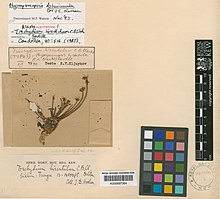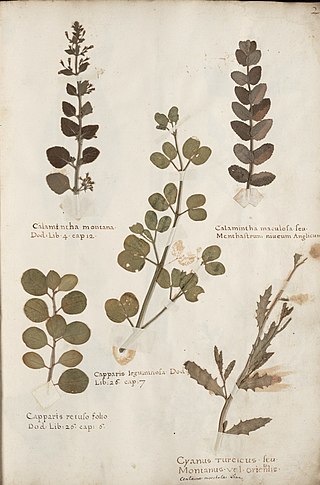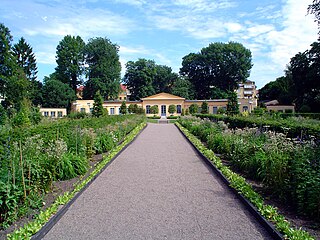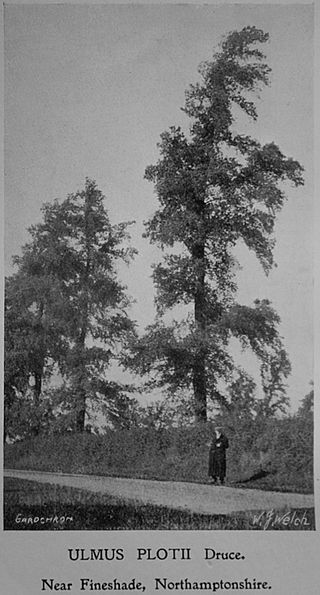In taxonomy, a kleptotype is an unofficial term referring to a stolen, unrightfully displaced type specimen or part of a type specimen. [1] [2] [3] [4]
Contents

In taxonomy, a kleptotype is an unofficial term referring to a stolen, unrightfully displaced type specimen or part of a type specimen. [1] [2] [3] [4]

The term is composed of klepto-, from the Ancient Greek κλέπτω (kléptō) meaning "to steal", [5] [6] and -type referring to type specimens. It translates to "stolen type".[ citation needed ]
During the second world war biological collections, like the herbarium in Berlin have been destroyed. This led to the loss of type specimens. [7] [8] In some cases only kleptotypes have survived the destruction, as the type material had been removed from their original collections. [8] For instance, the type of Taxus celebica was thought to be destroyed during the second world war, but a kleptotype has survived the war in Stockholm. [9]
Kleptotypes have been taken by researchers, who subsequently added their unauthorised type duplicates to their own collections. [10]
Taking kleptotypes has been criticised as destructive, wasteful, and unethical. The displacement of type material complicates the work of taxonomists, as species identities may become ambiguous due to the lacking type material. [10] It can cause problems, as researchers have to search in multiple collections to get a complete perspective on the displaced material. [11] [10] To combat this issue it has been proposed to weigh specimens before loaning types, and to identify loss of material through comparing the types weight upon return. [12] Also, in some herbaria, such as the herbarium Kew, specimens are glued to the herbarium sheets to hinder the removal of plant material. However, this also makes it difficult to handle the specimens. [13]
The International Code of Nomenclature for algae, fungi, and plants (ICN) does not explicitly prohibit the removal of material from type specimens, however it strongly recommends to conserve the type specimens properly. [2] It is paramount that types remain intact, as they are an irreplaceable resource [11] and point of reference.

A herbarium is a collection of preserved plant specimens and associated data used for scientific study.

The International Code of Nomenclature for algae, fungi, and plants is the set of rules and recommendations dealing with the formal botanical names that are given to plants, fungi and a few other groups of organisms, all those "traditionally treated as algae, fungi, or plants". It was formerly called the International Code of Botanical Nomenclature (ICBN); the name was changed at the International Botanical Congress in Melbourne in July 2011 as part of the Melbourne Code which replaced the Vienna Code of 2005.

In biology, a type is a particular specimen of an organism to which the scientific name of that organism is formally associated. In other words, a type is an example that serves to anchor or centralizes the defining features of that particular taxon. In older usage, a type was a taxon rather than a specimen.
In biological nomenclature, a syntype is any one of two or more biological types that is listed in a description of a taxon where no holotype was designated. Precise definitions of this and related terms for types have been established as part of the International Code of Zoological Nomenclature and the International Code of Nomenclature for algae, fungi, and plants.

The International Association for Plant Taxonomy (IAPT) is an organization established to promote an understanding of plant biodiversity, facilitate international communication of research between botanists, and oversee matters of uniformity and stability in plant names. The IAPT was founded on July 18, 1950, at the Seventh International Botanical Congress in Stockholm, Sweden. The IAPT headquarters is located in Bratislava, Slovakia. Its president, since 2017, is Patrick S. Herendeen of the Chicago Botanic Garden; vice-president is Gonzalo Nieto Feliner of the Real Jardín Botánico, Madrid; and secretary-general is Karol Marhold of the Plant Science and Biodiversity Centre, Slovak Academy of Sciences, Bratislava.
Nomenclature codes or codes of nomenclature are the various rulebooks that govern biological taxonomic nomenclature, each in their own broad field of organisms. To an end-user who only deals with names of species, with some awareness that species are assignable to genera, families, and other taxa of higher ranks, it may not be noticeable that there is more than one code, but beyond this basic level these are rather different in the way they work.
In botany, an infraspecific name is the scientific name for any taxon below the rank of species, i.e. an infraspecific taxon or infraspecies. A "taxon", plural "taxa", is a group of organisms to be given a particular name. The scientific names of botanical taxa are regulated by the International Code of Nomenclature for algae, fungi, and plants (ICN). This specifies a three part name for infraspecific taxa, plus a connecting term to indicate the rank of the name. An example of such a name is Astrophytum myriostigma subvar. glabrum, the name of a subvariety of the species Astrophytum myriostigma.

Ulmus wallichianaPlanch., the Himalayan elm, also known as the Kashmir elm and Bhutan elm, is a mountain tree ranging from central Nuristan in Afghanistan, through northern Pakistan and northern India to western Nepal at elevations of 800–3000 m. Although dissimilar in appearance, its common name is occasionally used in error for the cherry bark elm Ulmus villosa, which is also endemic to the Kashmir, but inhabits the valleys, not the mountain slopes. The species is closely related to the wych elm U. glabra.

James Lauritz Reveal was a U.S. botanist best known for his contributions to the genus Eriogonum and for his work on suprageneric names. His website, at PlantSystematics.org, also presents material on plant taxonomy including the Reveal system. He published extensively on North American flora, was a member of the Angiosperm Phylogeny Group, and was one of the authors of the APG II and APG III classifications.

The Field Elm cultivar Ulmus minor 'Plotii', commonly known as Lock Elm or Lock's Elm, Plot's Elm or Plot Elm, and first classified as Ulmus sativaMill. var. Lockii and later as Ulmus plotii by Druce in 1907-11, is endemic mainly to the East Midlands of England, notably around the River Witham in Lincolnshire, in the Trent Valley around Newark-on-Trent, and around the village of Laxton, Northamptonshire. Ronald Melville suggested that the tree's distribution may be related to river valley systems, in particular those of the Trent, Witham, Welland, and Nene. Two further populations existed in Gloucestershire. It has been described as Britain's rarest native elm, and recorded by The Wildlife Trust as a nationally scarce species.

In zoology and botany, a paratype is a specimen of an organism that helps define what the scientific name of a species and other taxon actually represents, but it is not the holotype. Often there is more than one paratype. Paratypes are usually held in museum research collections.
The Australian Plant Name Index (APNI) is an online database of all published names of Australian vascular plants. It covers all names, whether current names, synonyms or invalid names. It includes bibliographic and typification details, information from the Australian Plant Census including distribution by state, links to other resources such as specimen collection maps and plant photographs, and the facility for notes and comments on other aspects.
A species description is a formal scientific description of a newly encountered species, usually in the form of a scientific paper. Its purpose is to give a clear description of a new species of organism and explain how it differs from species that have been described previously or are related. To be considered valid, a species description must follow guidelines established over time. Naming requires adherence to respective codes, for example: in zoology, the International Code of Zoological Nomenclature (ICZN); plants, the International Code of Nomenclature for algae, fungi, and plants (ICN); viruses, the International Committee on Taxonomy of Viruses (ICTV). The species description often contains photographs or other illustrations of type material along with a note on where they are deposited. The publication in which the species is described gives the new species a formal scientific name. Some 1.9 million species have been identified and described, out of some 8.7 million that may actually exist. Millions more have become extinct throughout the existence of life on Earth.
Adolph Daniel Edward Elmer was an American botanist and plant collector. He was mostly active in the Philippines, his collections being described as new species by both himself and other botanists. The Japanese sent him into Santo Tomas Internment Camp during the Philippines campaign and he died there.
In biology, determination is the process of matching a specimen of an organism to a known taxon, for example identifying a plant. The term is also used in cellular biology, where it means the act of the differentiation of stem cells becoming fixed. Various methods are used, for example single or multi-access identification keys.
The University of Michigan Herbarium is the herbarium of the University of Michigan in Ann Arbor, Michigan, in the United States. One of the most-extensive botanical collections in the world, the herbarium has some 1.7 million specimens of vascular plants, algae, bryophytes, fungi, and lichens, and is a valuable resource for teaching and research in biology and botany. The herbarium includes many rare and extinct species.

The Estonian Museum of Natural History is the Estonian national museum for natural history. It is situated in Tallinn's Old Town.
Josephine (Pina) Milne is an Australian bryologist, and former Manager Collections at the National Herbarium of Victoria at the Royal Botanic Gardens Victoria.
David van Royen was a Dutch physician and botanist who worked at the Leiden Botanical Gardens where he succeeded his uncle Adriaan van Royen (1704-1779) as director.

Exsiccata is a work with "published, uniform, numbered set[s] of preserved specimens distributed with printed labels". Typically, exsiccatae refer to numbered collections of dried herbarium specimens respectively preserved biological samples published in several duplicate sets with a common theme/ title like Lichenes Helvetici. Exsiccatae are regarded as scientific contributions of the editor(s) with characteristics from the library world and features from the herbarium world. Exsiccatae works represent a special method of scholarly communication. The text in the printed matters/published booklets is basically a list of labels (schedae) with informations on each single numbered exsiccatal unit. Extensions of the concept occur.